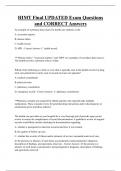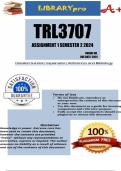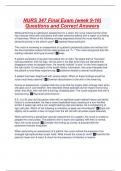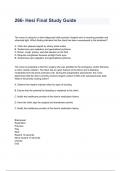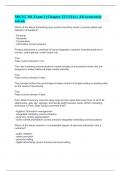and CORRECT Answers
An example of a primary data source for health care statistics is the
A. accession register.
B. disease index.
C. health record.
D. MPI. - Correct Answer- C. health record.
**"Disease index," "accession register," and "MPI" are examples of secondary data sources.
The health record is a primary source of data.
Which of the following is a form or view that is typically seen in the health record of a long-
term care patient but is rarely seen in records of acute care patients?
A. medical consultation
B. physical exam
C. pharmacy consultation
D. emergency record - Correct Answer- C. pharmacy consultation
**Pharmacy consults are required for elderly patients who typically take multiple
medications. These consults review for potential drug interactions and/or discrepancies in
medications given and those ordered.
The health care providers at your hospital do a very thorough job of periodic open record
review to ensure the completeness of record documentation. A qualitative review of surgical
records would likely include checking for documentation regarding
A. whether a postoperative infection occurred and how it was treated.
B. the quality of follow-up care.
C. whether the severity of illness and/or intensity of service warranted acute level care.
D. the presence or absence of such items as preoperative and postoperative diagnosis,
description of findings, and specimens removed. - Correct Answer- D. the presence or
absence of such items as preoperative and postoperative diagnosis, description of findings,
and specimens removed.
,**"Whether a postoperative infection occurred and how it was treated" represents an
appropriate job for the infection control officer. "The quality of follow-up care" represents the
clinical care evaluation process, rather than the review of quality documentation. "Whether
the severity of illness and/or intensity of service warranted acute level care" is a function of
the utilization review program. The correct answer is "the presence or absence of such items
as preoperative and postoperative diagnosis, description of findings, and specimens
removed."
For inpatients, the first data item collected of a clinical nature is usually
A. expected payer.
B. review of systems.
C. principal diagnosis.
D. admitting diagnosis. - Correct Answer- D. admitting diagnosis.
**Clinical data include all health care information collected during a patient's episode of
care. During the registration or intake process, the admitting diagnosis, provided by the
attending physician, is entered on the face sheet. If the patient is admitted through the ED, the
chief complaint listed on the ED record is usually the first clinical data collected. The
principal diagnosis is often not known until after diagnostic tests are conducted.
Demographic data are not clinical in nature. The review of systems is collected during the
history and physical, which is typically done after admission to the hospital.
You have been asked to identify every reportable case of cancer from the previous year. A key
resource will be the facility's
A. patient index.
B. number control index.
C. disease index.
D. physicians' index. - Correct Answer- C. disease index.
**The major sources of case findings for cancer registry programs are the pathology
department, the disease index, and the logs of patients treated in radiology and other
outpatient departments. The number index identifies new health record numbers and the
patients to whom they were assigned. The physicians' index identifies all patients treated by
each doctor. The patient index links each patient treated in a facility with the health number
under which the clinical information can be located.
,Joint Commission does not approve auto authentication of entries in a health record. The
primary objection to this practice is that
A. it is too easy to delegate use of computer passwords.
B. evidence cannot be provided that the physician actually reviewed and approved each
report.
C. electronic signatures are not acceptable in every state.
D. tampering too often occurs with this method of authentication. - Correct Answer- B.
evidence cannot be provided that the physician actually reviewed and approved each report.
**Auto authentication is a policy adopted by some facilities that allow physicians to state in
advance that transcribed reports should automatically be considered approved and signed (or
authenticated) when the physician fails to make corrections within a preestablished time
frame (e.g., "Consider it signed if I do not make changes within 7 days."). Another version of
this practice is when physicians authorize the HIM department to send weekly lists of
unsigned documents. The physician then signs the list in lieu of signing each individual
report. Neither practice ensures that the physician has reviewed and approved each report
individually.
As the chair of a Forms Review Committee, you need to track the field name of a particular
data field and the security levels applicable to that field. Your best source for this information
would be the
A. facility's data dictionary.
B. MDS.
C. UHDDS.
D. glossary of health care terms. - Correct Answer- A. facility's data dictionary.
**"MDS" and "UHDDS" are types of data sets for collecting data in long-term (MDS) and
acute care (UHDDS) facilities. A data dictionary should include security levels for each field
as well as definitions for all entities.
In the past, Joint Commission standards have focused on promoting the use of a facility-
approved abbreviation list to be used by hospital care providers. With the advent of the
commission's national patient safety goals, the focus has shifted to the
A. use of prohibited or "dangerous" abbreviations.
B. flagrant use of specialty-specific abbreviations.
C. prohibited use of any abbreviations.
, D. use of abbreviations in the final diagnosis. - Correct Answer- A. use of prohibited or
"dangerous" abbreviations.
**As part of its National Patient Safety Goals initiative, the Joint Commission required
hospitals to prohibit abbreviations that have caused confusion or problems in their
handwritten form, such as "U" for unit, which can be mistaken for "O". Spelling out the word
"unit" is preferred.
One of the Joint Commission National Patient Safety Goals (NSPGs) requires that health care
organizations eliminate wrong-site, wrong-patient, and wrong-procedure surgery. In order to
accomplish this, which of the following would NOT be considered part of a preoperative
verification process?
A. Review the medical records and/or imaging studies.
B. Mark the surgical site.
C. Follow the daily surgical patient listing for the surgery suite if the patient has been
sedated.
D. Confirm the patient's true identity. - Correct Answer- C. Follow the daily surgical patient
listing for the surgery suite if the patient has been sedated.
**"Confirm the patient's true identity," "mark the surgical site," and "review the medical
records and/or imaging studies"—these are usually in the protocol to prevent wrong site,
wrong patient, or wrong surgery. The correct answer is following the daily surgical patient
listing—that choice would NOT be an appropriate step in making sure you have the correct
identity of the patient, the correct site, or the correct surgery.
During a retrospective review of Rose Hunter's inpatient health record, the health information
clerk notes that on day 4 of hospitalization, there was one missed dose of insulin. What type
of review is this clerk performing?
A. utilization review
B. qualitative review
C. legal review
D. quantitative review - Correct Answer- B. qualitative review
**Quantitative analysis involves checking for the presence or absence of necessary reports
and/or signatures, while qualitative analysis may involve checking documentation
consistency, such as comparing a patient's pharmacy drug profile with the medication
administration record.

